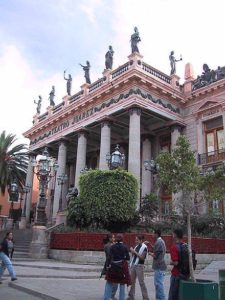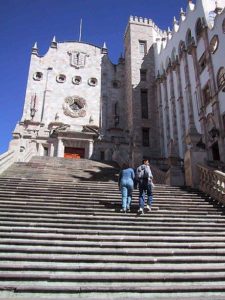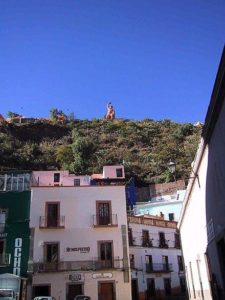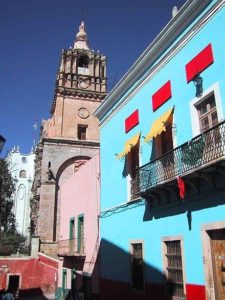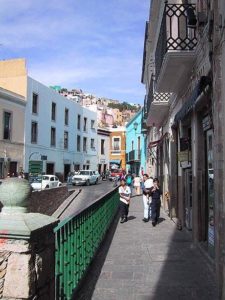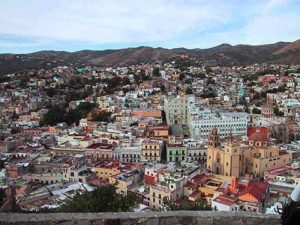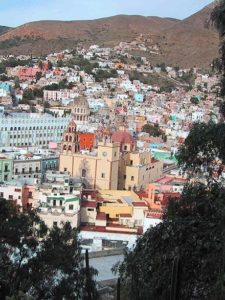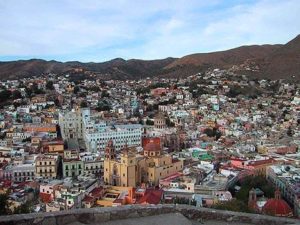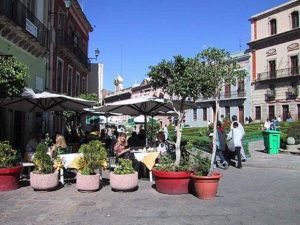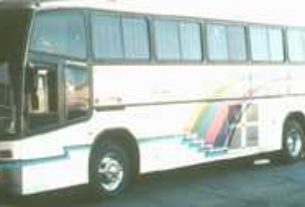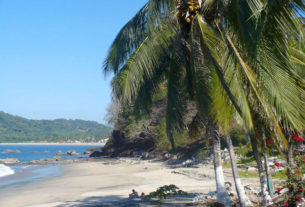The city of Guanajuato is nestled in a sort of steep basin in the Sierra Madre Mountains and spreads up around the center of the basin. Imagine a huge, terraced rice paddy such as we’ve seen in photos of Indochina. Then, imagine a city built on those terraces, a city in which there are practically no buildings over three or four stories high, in which most streets are cobbled or flat stones. Imagine that most of its small “downtown” resembles the old parts of Paris or London or Madrid. Imagine that from its small main streets rise little alleys ( callejones, pronounced kay-yeh-hone-es) made of stone steps and a stretch that’s flat, then more steps, some steeper than others, rising into the hills, into the sky. That’s Guanajuato.
When I first arrived in August of 1999, I lived on one of those callejones – the subida to Pípila, a monument to the hero of the Revolution of 1810 which looks out over the city from a considerable height – in the house of some friends, Ann Troutner and Paul Marioni. Ann and Paul are West Coast artists who work in glass and divide their time between Seattle and Guanajuato when they are not travelling all over the world setting up installations and the large works that various institutions commission from them. Two months later, I moved to another house that they own a little farther up the callejon, with a spectacular view of the city. Yes, I DID get a baby grand piano in here. People in Guanajuato can move anything anywhere.
As with many places in this city, walking is the only way to get to my house. One friend here observed that you have to work to get here, and the effort involved makes the arrival more precious. Certainly the panoramic view from my roof, gorgeous at any hour, is a reward beyond rubies, ample payment for the work of climbing up.
Guanajuato is about 400 kilometers NNW of Mexico City and is the capital of the State of Guanajuato. It’s an old city. Cortes arrived in Veracruz in 1519, and the Spaniards lost little time in exploring — and exploiting – the riches of the hemisphere on which Columbus had stumbled a few years before. They made their way north in short order once they discovered that there were precious metals in the Sierra Madre. Marfil, now a suburb of Guanajuato, was a mining camp in those days. By 1554, it and various other camps in the area had merged into Guanajuato. In 1871, having some 20,000 inhabitants, Guanajuato was large enough to be declared a city by Felipe IV of Spain. The name, Guanajuato, comes from Qanax’uato, a Tarascan Indian phrase meaning “place of the frogs.”(I haven’t noticed an unusual number, but who knows?)
At 2,000 meters, (about 5,500 feet) we are almost as high here as Mexico City, whose elevation is 2,200 meters. People in the US ask me, “Aren’t you bothered by the altitude?” I have to say that I think I’m not. At least I haven’t noticed any of the effects that some people describe, such as shortness of breath or caffeine or alcohol having more of an effect than at sea level. In fact, one of the exhilarating things about Guanajuato is its incredibly clean, clear, dry air. There is no polluting industry here. We hear no airplanes, an absence which constitutes bliss for a New Jerseyan. The sky at night is an amazing deep sapphire. The streetlights a kind of golden-ish color, not the stark white I’m used to in the US. From my windows, their light looks like the glow of large candles dotting the city. Perhaps, because of this lower level of ambient light, the stars look intimate and close. That’s the scientific explanation; personally, I agree with the indigenous peoples, that it’s because the sky IS closer here.
My father’s people are Guanajuatense. In fact, my grandfather came from Silao, a neighboring city (where the airport is) and my grandmother from Guanajuato. They were married here in September of 1914. I didn’t get here, in spite of several visits to Mexico, until August of 1997, and even then for only a short visit, not realizing how deeply this place would enchant me. Being here, playing this music, which has called me for a long time, now, working here, is truly wonderful.
Guanajuato is in the heart of what in Mexico is called Bajio, meaning “lowland,” which is in the heart of the Altiplano, the plateau between the Sierra Madre Occidental to the west and the Sierra Madre Oriental to the east, the twin mountain ranges which run down the sides of Mexico like a wreath of double thirds. Lowland sounds strange for an area whose average altitude is 5,500 to 7,000 feet, but compared to the surrounding mountains, we are, comparatively speaking, low.
I have heard some people in Mexico City make fun of Guanajuato because it is in the provincias, but to me it combines the best qualities of a small city (vibrant cultural life with music, film, museums) with a lot of what I love about my United States hometown of Roosevelt, N.J. (sense of community, mutual support, people close by, everybody-knows-everybody ambience). Also I love just walking around the city in the normal course of living here. You can imagine that the climb to the house is incredible exercise. The first time I did it, I thought the climb would never end and I was almost completely winded. Now it feels normal. Even Guanajuatenses get a teeny bit out of breath climbing, but in general they are like mountain goats; the kids go running up and down these passageways with never a second thought.
My teaching at the Escuela de Musica basically involves the kind of teaching I’ve longed to do for years: a workshop in contemporary music performance, which meets intensively once a week for two hours.
I teach at the Escuela de Música, an old building, and like almost all buildings here, it’s made of stone. When it was built, soundproofing was not yet a gleam in anyone’s eye. It was not built with practice rooms in mind, or administrative offices, or anything of the kind. In its central patio, open to the sun, the moon, and the rain, people gather to take a break or chat. Around the patio are rooms with old plaster on the walls, 12-foot ceilings, and a shortage of good pianos as well as of space overall. Upstairs, it unfolds, Guanajuato-style, into a rabbit warren of curves and little tiny spaces in unpredictable places.
Guitar students cram themselves into tiny crannies, up above a trumpeter blares. In one of the larger rooms there is a solfege class (singing practice, using scales), or one of composer Ramón Montes de Oca´s wonderful lectures on Chopin, or Webern, or Renaissance music. Next door in a tiny room with an ancient piano, Hector Quintanar teaches a composition student. Half a level downstairs, Director Francisco Ramírez’ tiny peaceful office joins with his secretary’s area, which looks out onto a garden.
In addition to my workshop, I also make myself available for individual coaching sessions and basically for whatever else I may be uniquely useful. I wanted from the beginning to make my class as inclusive as possible, so as to convey the sense that our art is joyful and open.
Since this is a seminar in interpretation of contemporary music, I include not just piano students but also other instrumentalists, singers AND composers. What better way for instrumentalists to learn that working with a real live composer is not to be feared, and for the composers to realize that, hey, the flute doesn’t speak so well in that register? To my delight, everybody here on the faculty seems to feel the same way. The students seem happy to be challenged. We are having a lot of fun with some intense discussions and the comments flying thick and fast. One of my rules is that pieces brought to the performance class portion of the workshop don’t have to be performance-ready – this gives us the opportunity to look at the “process,” how we work on a piece of music, interpret the score, make the music part of us.
I feel joyful to be teaching here, because I fell instantly in love with Guanajuato…the light, the air, and the music everywhere. The deep sapphire tranquility of the city at night; how it feels to be playing my instrument with the view of this extraordinarily warm and intimate city through the window, the eagerness and openness of the students and the almost instant sense of camaraderie with my colleagues at the Escuela de Musica…all these things are essential threads in what feels remarkably similar to an unfolding piece of music.
What music am I playing? Check into future articles on MexConnect for that information and some reviews of Cervantino festivals.

